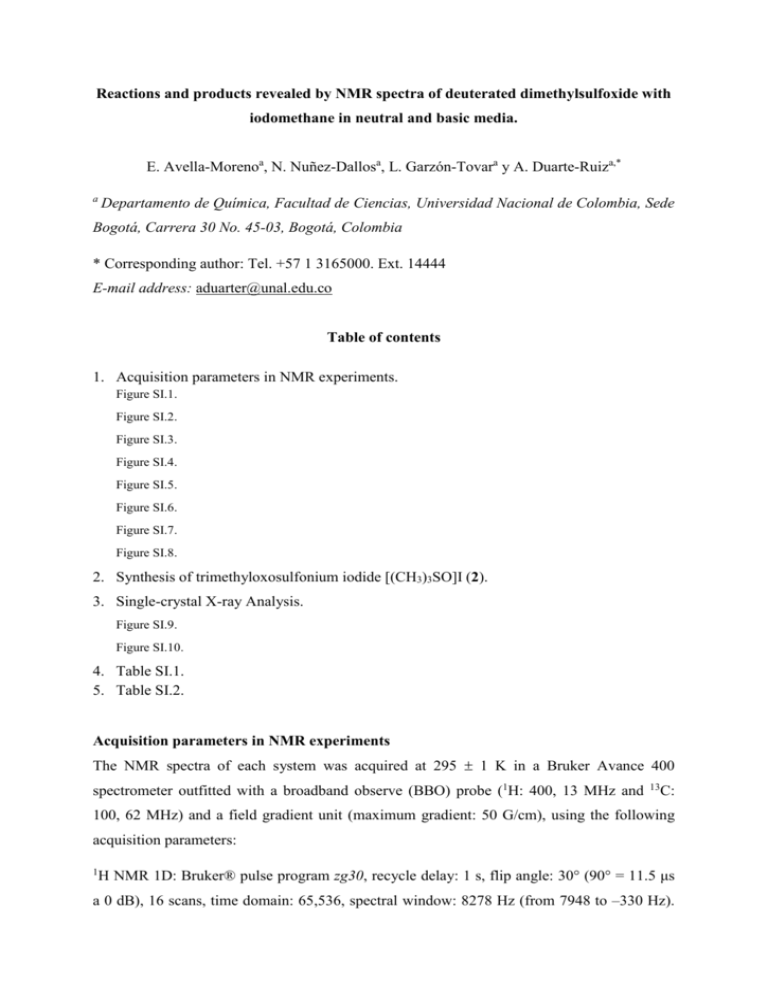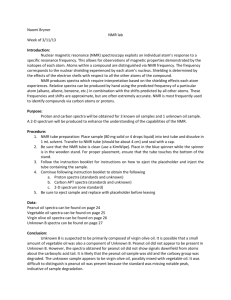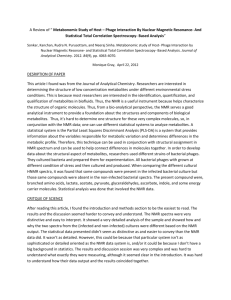Reactions and products revealed by NMR spectra of deuterated
advertisement

Reactions and products revealed by NMR spectra of deuterated dimethylsulfoxide with iodomethane in neutral and basic media. E. Avella-Morenoa, N. Nuñez-Dallosa, L. Garzón-Tovara y A. Duarte-Ruiza,* a Departamento de Química, Facultad de Ciencias, Universidad Nacional de Colombia, Sede Bogotá, Carrera 30 No. 45-03, Bogotá, Colombia * Corresponding author: Tel. +57 1 3165000. Ext. 14444 E-mail address: aduarter@unal.edu.co Table of contents 1. Acquisition parameters in NMR experiments. Figure SI.1. Figure SI.2. Figure SI.3. Figure SI.4. Figure SI.5. Figure SI.6. Figure SI.7. Figure SI.8. 2. Synthesis of trimethyloxosulfonium iodide [(CH3)3SO]I (2). 3. Single-crystal X-ray Analysis. Figure SI.9. Figure SI.10. 4. Table SI.1. 5. Table SI.2. Acquisition parameters in NMR experiments The NMR spectra of each system was acquired at 295 1 K in a Bruker Avance 400 spectrometer outfitted with a broadband observe (BBO) probe (1H: 400, 13 MHz and 13 C: 100, 62 MHz) and a field gradient unit (maximum gradient: 50 G/cm), using the following acquisition parameters: 1 H NMR 1D: Bruker® pulse program zg30, recycle delay: 1 s, flip angle: 30° (90° = 11.5 μs a 0 dB), 16 scans, time domain: 65,536, spectral window: 8278 Hz (from 7948 to –330 Hz). The spectra were acquired from 0.3 h to 343.2 days for system I and from 1.8 h to 307.0 days for system II. C NMR 1D: Bruker® pulse program zg30, recycle delay: 2 s, flip angle: 30° (90° = 9.0 μs 13 to 3 dB), 256 scans; time domain: 65,536, spectral window: 22,075 Hz (from 19,000 to – 3075 Hz). 1 H-13C NMR 2D: Bruker® pulse program inv4gpqf, for HMQC, and inv4gplplrndqf for HMBC, recycle delay: 1.5 s, 16 scans, time domain: 65,536 in the direct dimension, F2, and 512 spectra in the indirect dimension, F1, spectral window: 3592.0 Hz in F2 and 12,073.6 Hz in F1 spectra, using JHC = 145 Hz. The spectra were acquired for System I at 12.92, and at 343.2 days after the mixture of reagents, and for System II at 13.27, at 107, and at 330 days. NMR DOSY: 1H, Bruker® pulse program stebppg1s, Δ: 100 ms, δ: 1700 μs, linear gradient in z of 12 steps, spectra with 16 scans, time domain: 65,536, spectral window: 7183.9 Hz. C, pulse program stebpgpin1s, Δ: 80 ms, δ: 900 μs, linear gradient in z of 12 steps, spectra 13 with 1024 scans, time domain: 32,768, spectral window: 2454.6 Hz, 300 K. The spectra were acquired for System I at 307.5 days and for System II, at 307.5 days after the mixture of reagents. The spectra were processed with MestReC® 4.8.6.0, and the DOSY spectra were processed with MestReNova® 6.0.2-54751. — Figure SI.1. — — Figure SI.2. — — Figure SI.3. — — Figure SI.4. — — Figure SI.5. — — Figure SI.6. — 1 Licensed by MestRelab Research, S. L., Rua San Xosé, Paseo No. 6, 5o. C, Santiago de Compostela, La Coruña, Spain. — Figure SI.7. — — Figure SI.8. — Synthesis of trimethyloxosulfonium iodide [(CH3)3SO]I (2) CH3I (3.4 g, 24.1 mmol) was added to DMSO (11.0 g, 140.9 mmol). The resulting mixture was ultrasonicated for 2 hours. The obtained yellow solution was kept at 20 °C for 6 days, with continuous agitation. The color of the solution changed from yellow to red, and a white precipitate was formed. Furthermore, single crystals were grown from the DMSO solution. The precipitate and colorless crystals were filtered, washed with cold ethanol and identified as 2. The yield obtained was 0.7 g, 13%. 1H NMR (DMSO-d6): δ 3.87 (s, 9H). 13 C NMR (DMSO-d6): δ 39.0 (CD3). IR (KBr, cm-1): 2962 (vs), 2880 (s), ν(C-H); 1402 (s), 1339 (w), 1312 (m), δ(C-H); 1229 (vs), ν(S=O); 1039 (vs), 952(s), δ(C-H); 757 (m), ν(C-S). Single-crystal X-ray Analysis Crystals of 2 (12) were suitable for analysis by single-crystal X-ray diffraction (XRD). Data collection was performed on a Nonius Kappa CCD equipped with graphite-monochromatized Mo Kα radiation (λ=0.71073 Å) at 233 K. All non-hydrogen atoms were refined with anisotropic displacement parameters. Hydrogen atoms were calculated and refined using a riding model, with C─H = 0.94–0.98 Å and Uiso(H) = 1.2 or 1.5 times Ueq(C). — Figure SI.9. — — Figure SI.10. — ...... The concentration of species evolved during the reaction was determined by the integration of signals in the 1H NMR spectra series of systems I and II. The integral was measured using the sum of the integral of the signals of 1,4-dioxane and water as reference, deducting the water consumption in the formation of methanol, 5 and dimethyl ether, 7. The equations (molarity versus time) and the correlation coefficients, R2, were obtained from scatter plot made in Excel 2010®2. — Table SI.1. — 2 Licensed by Microsoft Corporation; Campus Agreement program with National University of Colombia. — Table SI.2. — Figures and tables captions Figure SI.1. The NMR spectra of system I at three different times (after the mixture of DMSO-d6 with CH3I) show the signals of: DMSO-d3, 4, methoxy-bis(trideuteromethyl)sulfonium iodide, 3, hexa-deuterated-, 2a, nona-deuterated trimethyloxosulfonium iodide, 2b, methanol, 5, and trideuterated dimethyl sulfide, 6, among others. The spectra are expanded δ: 2.47 to 2.55 (left); 3.75 to 4.05 and 2.45 to 2.55, above the 1H NMR spectra, and 38.0 to 40.4 (right); 61.0 to 62.0; 48.0 to 49.0; 27.2 to 24.8 and –22.0 to –20, above the 13C NMR spectra. Figure SI.2. The NMR spectra of system I at three different times (after the mixture of DMSO-d6, CH3I, NaOH, and H2O) show the signals of: DMSO-d3, 4, methoxy-bis(trideuteromethyl)sulfonium iodide, 3, hexa-deuterated trimethyloxosulfonium, 2a, [Na4(DMSO-dx)15][(I3)3I], 1a, methanol, 5, and trideuterated dimethyl sulfide, 6, and dimethyl ether, 7, among others. The spectra are expanded δ: 2.47 to 2.55(left); 3.80 to 4.05; 3.35 to 3.40 and 3.12 to 3.19, above the 1H NMR spectra, and 38.6 to 40.5 (right) and –21.3 to –20.7, above the 13 C NMR spectra. Figure SI.3. The spectra enlargement for system I and II at three different times (after the mixture of reagents) show signals that are not part of the septet in 39.51 ppm (δ: 38.88 - 40.14, DMSO-d6) and are attributable to DMSO-d3, 4, (δ: 40.29), hexa-deuterated-, 2a, (δ: 39.03; 39.02) and nona-deuterated trimethyloxosulfonium, 2b, (δ: 38.45; 38.51; 38.41) or [Na4(DMSO-dx)15][(I3)3I], 1a, (δ: 39.77). Figure SI.4. HMQC spectra of system I (after 343 days of mixture CH 3I with DMSO-d6 , similar to system II) show the 1H-13C one-bond correlations of DMSO-d3, 4, hexa-deuterated trimethyloxosulfonium, 2a, methanol, 5, trideuterated dimethylsulfide, 6, and dimethyl ether, 7, among others. The CH3I signal disappears. Figure SI.5. HMQC spectra of system I (after 107 days of mixture CH 3I, DMSO-d6, NaOH and water) show the 1 H-13C one-bond correlations of DMSO-d3, 4, [Na4(DMSO-dx)15][(I3)3(I)], 1a, hexa-deuterated trimethyloxosulfonium, 2a, trideuterated dimethyl sulfide, 6, and dimethyl ether, 7, among others. The CH3I signal disappears. Figure SI.6. The RMN 13C spectra enlargement (acquired in the final stage of the system I monitoring) show all signals (a - g) of the septet generated by one-bond coupling of C-D in CD3 groups of deuterated species; nonadeuterated trimethyloxosulfonium iodide, 2b, methanol, 5b, dimethylsulfide, 6b, and dimethyl ether, 7b, produced in the reaction medium, and DMSO-d6, used as solvent. Figure SI.7. The 1H NMR spectra enlargement for system I and II after the mixture of reagents. The region between 0.80 to 1.30 ppm shows the signals of the hydrogens bonded to sp3 carbon of aliphatic hydrocarbons. Figure SI.8. NMR DOSY spectra of system II (after 340 days of mixture CH3I, DMSO-d6, NaOH and water) show the diffusion of chemical species presents in the reaction medium, and these are in agreement with the signals assignment from the table 1. This indicates the presence of aliphatic hydrocarbons. Figure SI.9. Crystal structure of [Na4(DMSO)15][(I3)3(I)] 1. Thermal ellipsoids are drawn with a 30% probability level. Hydrogen atoms are omitted for clarity. Adapted with the permission of [12] (Duarte-Ruiz A, Núñez-Dallos N, Garzón-Tovar L, Wurtz K, Avella-Moreno E, Gómez-Baquero F, Synthesis and structure of [Na4(DMSO)15][(I3)3(I)]. Self-assembly of hexacoordinated sodium. Chem Commun. 2011;47(25):7110-7112). Figure SI.10. Crystal structure of [(CH3)3SO]I 2. Thermal ellipsoids are drawn with a 30% probability level 3. Table SI.1. Equations of the trend lines of molarity, [M] Vs. time, t, of some species detected during the NMR analysis of the system I. Table SI.2. Equations of the trend lines of molarity, [M] Vs. time, t, of some species detected during the NMR analysis of the system II. Figure SI.1. 3 DRX previously published (O. Knop, A. Linden, B. R. Vincent, S. C. Choi, T. S. Cameron, R. J. Boyd (1989) Can. J. Chem., 67, 1984; M. Jannin, R. Puget, C. de Brauer, R. Perret (1991) Acta Crystallogr., Sect.C: Cryst. Struct. Commun., 47, 1687). Figure SI.2. Figure SI.3. Figure SI.4. Figure SI.5. Figure SI.6. Figure SI.7. Figure SI.8. Figure SI.9. Figure SI.10. Between t = and t = 18 min. [M] 36 min. 27 d, 21 h 1 d, 1 h [CH3 I](I) [3](II) 36 min. 11 d, 21 h [3](III) 18 min. 3d [2a](I) = f (t ) = 0.741e ([M] mol/L and t: hours) R ̶ 0.00719t –3 = – 1.86 10 ln t + 8.29 10 –3 = 7.80 10 t –3 – 0.330 2 Nr. 0.989 1 0.99 2 0.953 3 –5 2 –3 –3 0.998 4 –6 2 –3 –1 = – 2.52 10 t + 6.33 10 t + 2.92 10 3d 11 d, 21 h [2a](II) = – 8.14 10 t + 3.77 10 t + 1.00 10 0.997 5 11 d, 21 h 12 d, 1 h [2a](III) = – 6.74 10 t + 19.7 1.0* 6 12 d, 1 h 2 m, 24 d [2a](IV) = 3.02 10–8 t 2 – 1.41 10–4 t + 2.76 10–1 0.999 7 17 h, 48 min. 6 d, 19 h [4](I) = 1.24 10–6 t 2 + 4.04 10–5 t – 4.32 10–4 0.998 8 3 d, 23 h 11 d, 21 h [4](II) = – 1.56 10–6 t 2 + 7.75 10–4 t – 4.66 10–2 0.991 9 11 d, 21 h 12 d, 1 h [4](III) = 7.00 10–3 t – 1.96 1.0* 10 12 d. 1h 11 m, 13 d [4](IV) = 8.47 10–13 t 3 – 1.57 10–8 t 2 + 1.16 10–4 t + 4.06 10–2 0.995 11 –2 * Two points interpolated by a line segment with the aim to highlight the stage when 2a precipitated. m = month (s), d = day (s), h = hour (s), min. = minute (s). R 2 = correlation coefficient, Nr. = equation number. Table SI.1. Between t = and t = [M] = f (t ) [M]: mol/L t: hours 1h, 48 min. 1 m, 2 d 1 m, 2 d 10 m, 7 d 1h, 48 min. 8 d, 8 h 1h, 48 min. 7 d, 1 h 4 d, 23 h 8 d, 8 h [CH3 I](I) = 6.96 10–1 e – 0.0063t [CH3 I](II) = 6.02 10–3 e – 0.00023t [3](I) = 4.82 10–12 t 4 – 2.50 10–9 t 3 + 3.95 10–7 t [2a](I) = ̶ 7.45 10–6 t 2 + 3.19 10–3 t + 7.36 10–4 [2a](II) = ̶ 5.85 10–5 t 2 + 1.80 10–2 t – 1.04 7 d, 1 h 1 m, 16 d [2a](III) = 2.09 t 25 d 10 m, 7 d [2a](IV) = 1.78 e 1h, 48 min. 1 m, 25 d 1 m, 26 d 10 m, 7 d [4](I) [4](II) = ̶ 1.48 10 t + 1.16 10 t – 5.39 10 1h, 48 min. 1 m, 25 d [5](I) = — 2.75 10 t + 4.48 10 t + 6.95 10 = 2.49 10–16 t 5 – 9.23 10–13 t 4 + 1.34 10–9 t 3 – 9.84 10–7 t 2 + 3.78 × 10–4 t + 9.91 × 10–3 1h, 48 min. 1 m, 25 d [6](I) = 1h, 48 min. 11 d [7](I) 22 h, 12 min. 10 m, 7 d [7](II) = 6.18 10–4 ln t + 3.43 10–2 –11 2 –7 –2 = — 9.52 10 t + 9.84 10 t + 3.69 10 m = month (s), d = day (s), h = hour (s), R 2 Nr. 0.994 0.960 12 0.998 14 0.999 15 0.998 16 – 0.4055 0.920 17 – 0.0003t 0.974 18 0.996 0.969 19 0.986 21 0.995 22 0.816 23 0.995 24 –8 2 –9 3.36 10–11 t min. = minute (s). –4 2 3 –5 – 8.77 10–8 t 2 – 2.28 10–5 t + 1.70 10–3 –4 –2 2 + 7.43 10–5 t + 2.05 10–3 R 2 = correlation coefficient, Nr. = equation number. Table SI.2. 13 20



